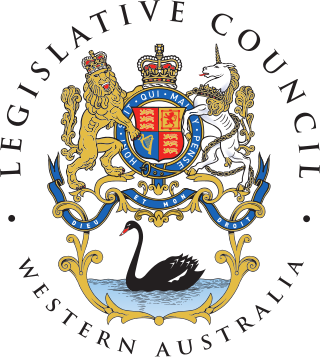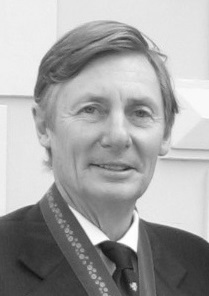Related Research Articles
The parliaments of the Australian states and territories are legislative bodies within the federal framework of the Commonwealth of Australia.

The New South Wales Legislative Council, often referred to as the upper house, is one of the two chambers of the parliament of the Australian state of New South Wales. Along with the Legislative Assembly, it sits at Parliament House in the state capital, Sydney. It is normal for legislation to be first deliberated on and passed by the Legislative Assembly before being considered by the Legislative Council, which acts in the main as a house of review.

The Legislative Council, or upper house, is one of the two chambers of the Parliament of South Australia. Its central purpose is to act as a house of review for legislation passed through the lower house, the House of Assembly. It sits in Parliament House in the state capital, Adelaide.

The Parliament of South Australia is the bicameral legislature of the Australian state of South Australia. It consists of the 47-seat House of Assembly and the 22-seat Legislative Council. General elections are held every 4 years, with all of the lower house and half of the upper house filled at each election. It follows a Westminster system of parliamentary government with the executive branch required to both sit in parliament and hold the confidence of the House of Assembly. The parliament is based at Parliament House on North Terrace in the state capital of Adelaide.

The Western Australian Legislative Council is the upper house of the Parliament of Western Australia, a state of Australia. It is regarded as a house of review for legislation passed by the Legislative Assembly, the lower house. The two Houses of Parliament sit in Parliament House in the state capital, Perth.

The Agricultural Region is a multi-member electoral region of the Western Australian Legislative Council, located in the South West, Peel and part of the Great Southern regions of the state. It was created by the Acts Amendment Act 1987, and became effective on 22 May 1989 with five members who had been elected at the 1989 state election three months earlier. At the 2008 election, it was increased to six members.

The East Metropolitan Region is a multi-member electoral region of the Western Australian Legislative Council, located in the eastern and south-eastern suburbs of Perth. It was created by the Acts Amendment Act 1987, and became effective on 22 May 1989 with five members who had been elected at the 1989 state election three months earlier. At the 2008 election, it was increased to six members.

The Mining and Pastoral Region is a multi-member electoral region of the Western Australian Legislative Council, located in the northern and eastern regions of the state. It was created by the Acts Amendment Act 1987, and became effective on 22 May 1989 with five members who had been elected at the 1989 state election three months earlier. At the 2008 election, it was increased to six members.

The South Metropolitan Region is a multi-member electoral region of the Western Australian Legislative Council, located in the southern suburbs of Perth, Western Australia. It was created by the Acts Amendment Act 1987, and became effective on 22 May 1989 with five members who had been elected at the 1989 state election three months earlier. At the 2008 election, it was increased to six members.

The South West Region is a multi-member electoral region of the Western Australian Legislative Council the South West, Peel and part of the Great Southern regions of the state. It was created by the Acts Amendment Act 1987, and became effective on 22 May 1989 with seven members who had been elected at the 1989 state election three months earlier. At the 2008 election, it was reduced to six members. The region includes the cities of Albany, Bunbury and Mandurah.
Grey Power was an Australian political party and lobby group, first registered in 1983. At the federal elections of 1984 and 1987 it ran candidates, but on both occasions these candidates did poorly. The group was designed to represent the elderly vote, advocating issues dealing with aged care and a mature perspective on national policy; hence the name "grey power".
The lower houses of the parliaments of the states and territories of Australia are divided into electoral districts. Most electoral districts send a single member to a state or territory's parliament using the preferential method of voting. The area of a state electoral district is dependent upon the Electoral Acts in the various states and vary in area between them. At present, there are 409 state electoral districts in Australia.

State elections were held in South Australia on 25 November 1989. All 47 seats in the South Australian House of Assembly were up for election. The incumbent Australian Labor Party led by Premier of South Australia John Bannon defeated the Liberal Party of Australia led by Leader of the Opposition John Olsen. Labor won 22 out of 47 seats, and secured a majority of 24 with the support of two Independent Labor members.

State elections were held in South Australia on 7 December 1985. All 47 seats in the South Australian House of Assembly were up for election. The incumbent Australian Labor Party led by Premier of South Australia John Bannon increased its majority, and defeated the Liberal Party of Australia led by Leader of the Opposition John Olsen.

State elections were held in South Australia on 12 July 1975. All 47 seats in the South Australian House of Assembly were up for election. The incumbent Australian Labor Party led by Premier of South Australia Don Dunstan won a third term in government, defeating the Liberal Party of Australia led by Leader of the Opposition Bruce Eastick.
This is a list of members of the South Australian Legislative Council between 1993 and 1997. As half of the Legislative Council's terms expired at each state election, half of these members were elected at the 1989 state election with terms expiring in 1997, while the other half were elected at the 1993 state election with terms expiring in 2002.
This is a list of members of the South Australian Legislative Council between 1989 and 1993. As half of the Legislative Council's terms expired at each state election, half of these members were elected at the 1985 state election with terms expiring in 1993, while the other half were elected at the 1989 state election with terms expiring in 1997.
This is a list of members of the South Australian Legislative Council between 1985 and 1989. As half of the Legislative Council's terms expired at each state election, half of these members were elected at the 1982 state election with terms expiring in 1989, while the other half were elected at the 1985 state election with terms expiring in 1993.
This is a list of members of the South Australian Legislative Council between 1982 and 1985. As half of the Legislative Council's terms expired at each state election, half of these members were elected at the 1979 state election with terms expiring in 1985, while the other half were elected at the 1982 state election with terms expiring in 1989.

The Western Australian Legislative Council was elected from six multi-member electoral regions, which are in turn composed of electoral districts which are used to elect the Legislative Assembly. The current number of electoral regions was established on 22 May 1989. Initially, the South West and Northern Metropolitan regions returned seven members to the Legislative Council, while the other regions each returned five members. This arrangement was changed to have each region return six members for the 2008 Western Australian election, increasing the total number of members from 34 to 36. Before 1989 electoral divisions for the Legislative Council were known as electoral provinces.
References
- ↑ "History of South Australian elections 1857-2006, volume 2 Legislative Council". ECSA. Retrieved 22 May 2016.